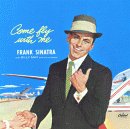|
Come Fly With Me, as this wonderfully engaging collection of
songs illustrating the theme of world travel was titled, is a continuation
of the brilliant series of thematically-organized albums Frank Sinatra
had begun recording shortly after signing with Capitol Records in early
1953. Recorded at three sessions in early October, 1957, the performances
stand as yet another milestone in a career crowded with them. For one
thing, they represented the singer's very first collaboration with arranger-conductor
Billy May, an inspired pairing that, as you'll hear, produced some of
the most satisfying, forceful and invigorating music Sinatra ever recorded.
There's more than a little irony in their having made these recordings
since four-and-a-half years earlier May had been the singer's first choice
arranger for his Capitol recordings.
In early 1953, while discussions went forward between Sinatra and Capitol's
executives regarding the strategy to be followed in his recordings for
the label, with which he had just signed an exclusive recording agreement,
his old friend and frequent collaborator during the previous decade, arranger-conductor
Axel Stordahl, was brought in to supervise Sinatra's first Capitol recording
session (for the fruits of this maiden effort, listen to the Sinatra CD
release Point Of No Return). This, however, was never regarded
as anything more than a stopgap measure by Capitol officials who wanted
the singer to pursue a more contemporary direction, one more vibrant and
forceful and, hopefully, innovative as well, than that associated with
Stordahl and Sinatra's Columbia recordings. Sinatra's loyalty to Stordahl
notwithstanding, the question of his continuing to serve as the singer's
alter ego was rendered moot when Stordahl signed on as musical director
for Eddie Fisher's television show, which necessitated his remaining in
New York City. It was at this point that Sinatra voiced the desire to
have Billy May assume musical direction of his recordings.
It was an appropriate choice, for the Pittsburgh-born May, following
more than a decade's experience, first as a trumpeter and later, increasingly,
as arranger, for a number of big bands, including those of Charlie Barnet,
Glenn Miller and Alvino Rey, had emerged as one of the most resourcefully
creative orchestrators of the late 1940s and early '50s. Nor was his experience
limited solely to dance and swing bands, for after settling in los Angeles
in the middle '40s he had gained wider expertise through extensive writing
for many popular radio and recording performers, often conducting as well.
By the end of the decade he had formed a close relationship with
Capitol Records, serving as musical director for many of the label's leading
artists and recording with them in a broad range of musical styles.
In the fall of 1951 may had assembled a recording band of his own, gaining
success with the novel glissando unison saxophone sound, slyly spiced
with brass punctuations, he devised for the group, among other innovations
in orchestral writing he introduced and which gave his music such a strong,
distinctive character, urbane, sophisticated and decidedly witty. What
had started out solely as an experimental studio outlet for his writing
soon blossomed into a full-fledged and full-time performing career. So
when Sinatra called on his services, May was unavailable, having taken
to the road with his touring band.
Enter Nelson Riddle. On the basis of his earlier activities for Capitol,
including having arranged two of the label's biggest hits, Nat Cole's
Unforgettable and Ella Mae Morse's Blacksmith Blues,
his name was put forward as a viable alternative to May's. Sinatra and
Riddle met for the first time at the singer's second Capitol recording
session, on April 30, 1950, and from the beginning it was apparent that
the pairing was of a special, singular, even magical character. Not everyone
at Capitol was convinced the collaboration would prove fruitful, however,
for Riddle was instructed to orchestrate two of the four selections to
be recorded in the style of Billy May, the other two as he felt most appropriate
to the occasion. How well he succeeded in fulfilling the former requirement
is evidenced by the fact that for many years it was assumed that South
Of the Border (included here) and I've Got The World On A String
had been arranged by May rather than Riddle. It was in the remaining two
selections Don't Worry 'Bout Me and I Love You, that
the characteristic Riddle orchestral sound was heard in sympathetic support
of the singer for the first time, initiating an association that was to
result in large numbers of superlative recordings, some of them among
the undisputed classics of American popular song, a generous portion of
hit singles and, as a result of all this, a revitalization of the singer's
career so complete as to eclipse his accomplishments of the previous decade.
Not only that, his collaboration with Riddle had brought Sinatra to the
very pinnacle of his art, stimulating and making possible his achieving
the phenomenal levels of focused artistry he attained so consistently
throughout his Capitol recordings.
As a result, Sinatra's first recorded meeting with May did not take place
until four-and-a-half years after his joining Capitol. After several years
of touring with his band, May had relinquished direction of the group
to Sam Donohue and returned to Los Angeles to resume his arranging-conducting
career. Finally, in the fall of 1957 the two entered Capitol's studios
to begin work on the present set of recordings. As you'll hear, the results
more than amply proved worth the wait.
On the basis of his invigorating writing for his own band, one might
have expected May to push the singer into an all-stops-out, rhythmically
swinging groove. After all, that's what May had excelled at. Expectiations
notwithstanding, Come Fly With Me turned out to be something
quite different entirely, a program of many and varied moods which May
orchestrated with some of his most helpfully imaginative and deliciously
colored writing ever, framing the singer as perfectly and sympathetically
as Riddle ever had and establishing once and for all his utter mastery
of the full breadth of popular orchestral writing. As a result, the performances
are among the finest, most assured and breathtakingly lovely the singer
ever recorded, his spacious, beautifully shaped, knowing interpretations
framed by orchestral settings of like sensitivity and subtlety. And rather
than comprising forceful, up-tempo swingers, the great bulk of Come
Fly With Me consisted of romantic ballad performances of rather slow
tempi.
Not all were of this ardent cast, however. Certainly On The Road
To Mandalay, with its zestfully exotic touches, and the rousing Brazil,
with its constantly shifting rhythmic tapestry, summon up the characteristic
May way with an orchestra, as do the breezy album title song and the equally
zesty Let's Get Away From it All. These provide wonderful contrast
to the more subdued romantic fare, the pensive, almost wistful treatment
accorded Around The World, for example, the fetching vocal wizardry
of London By Night, or the unhurried majesty of Moonlight
In Vermont, among other stunning performances that might be cited.
The only outright allusion to May's unique brand of musical wit occurs
on Isle Of Capri, which is given a bracing, light-hearted treatment,
sly and whimsical. Even the singer is affected by the almost tongue-in-cheek
approach; listen closely and you'll hear him sing on the song's third
verse, "She wore a lovely meatball on her finger; 'Twas goodbye at
the Villa Capri," the latter an allusion to a popular Italian restaurant
in Los Angeles.
This first meeting between the two proved so felicitous - and commercially
successful as well - that, happily for us, two further Sinatra-May collaborations
took place, Come Dance With Me, already released in CD form,
and Come Swing With me, an early CD release of which is planned.
For this compact disc version of Come Fly With Me, three additional
travel-related performances have been added to the original analog album,
all arranged and conducted by Nelson Riddle. Earliest of these is the
previously-mentioned South Of The Border, with Riddle sounding
very much like May, the breezily exuberant Chicago, from August
of 1957, a song forever associated with Sinatra, and from April 1960 the
warmly affectionate I Love Paris, another choice performance.
As one of the fine selections from this fetching album declares, "It's
nice to go trav'ling." And with Sinatra, May and Riddle at the helm,
it's purely a pleasure trip.
Pete Welding
Come Fly With Me (1958)
Capitol CDP 7 48469 2
Come Fly With Me
Around The World
Isle Of Capri
Moonlight In Vermont
Autumn In New York
On The Road To Mandalay
Let's Get Away From It All
April In Paris
London By Night
Brazil
Blue Hawaii
It's Nice To Go Trav'ling
Chicago
South Of The Border
I Love Paris
Buy Come
Fly With Me from Amazon.co.uk.
|
|


